 Multiple Choice Questions
Multiple Choice QuestionsThe Golgi complex plays a major role
in trapping the light and transforming it into chemical energy
in digesting proteins and carbohydrates
as energy transferring organelles
in post translational modification of proteins and glycosidation of lipids
D.
in post translational modification of proteins and glycosidation of lipids
Golgi complex plays a major role in post translational modification of proteins and glycosidation of lipids. Chloroplasts contain chlorophyll, which traps light and transform into chemical energy. Lysosomes are
involved in digesting proteins, fats and carbohydrates. Mitochondria are energy transferring organelles.
Which one of the following organelle in the figure correctly matches with its function?
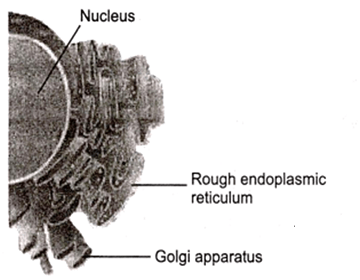
Rough endoplasmic reticulum, formation of glycoproteins
Golgi apparatus, protein synthesis
Golgi apparatus, formation of glycolipids
Rough endoplasmic reticulum, protein synthesis
Macromolecule chitin is
nitrogen containing polysaccharide
phosphorus containing polysaccharide
sulphur containing polysaccharide
simple polysaccharide
The essential chemical components of many coenzymes are
proteins
nuclei acids
carbohydrates
vitamins
A stage in cell division is shown in the figure. Select the answer which gives correct identification of the stage with its characteristics
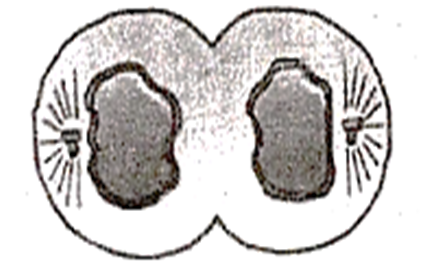
Telophase - Nuclear envelope reforms, Golgi complex reforms
Late anaphase - Chromosomes move away from equatorial plate, Golgi complex not present
Cytokinesis - Cell plate formed, mitochondria distributed between two daughter cells
Telophase - Endoplasmic reticulum and nucleolus not reformed yet
Select the correct match of the digested products in humans given in column I with their absorption site and mechanism in column II.
| Column I | Column II |
| Glycine and glucose | Small intestine and active absorption |
| Fructose and Na+ | Small intestine passive absorption |
| Glycerol and fatty acids | Duodenum and move as chilomicrons |
| Cholesterol and maltose | Large intestine and active absorption |
The figure shows a diagrammatic view of human respiratory system with labels A, B, C and D. Select the option, which gives correct identification and main function and/or characteristic.
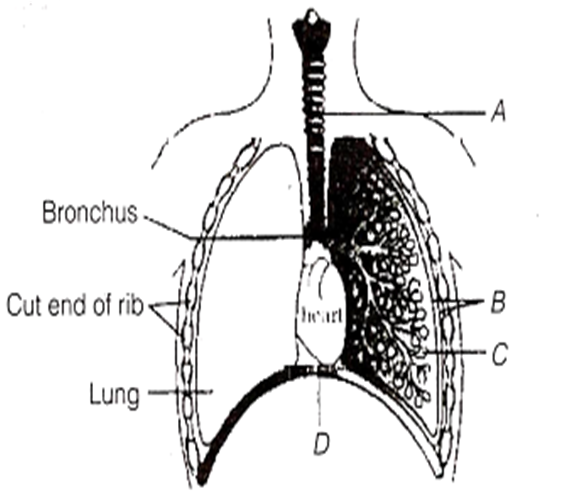
A - trachea - long tube supported by complete cartilaginous rings for conducting inspired air
B - pleural membrane-surround ribs on both sides to provide cushion against rubbing
C - alveoli - thin walled vascular bag-like structures for exchange of gases
D - lower end of lungs - diaphragm pulls it down during inspiration
Figure shows schematic plan of blood circulation in human with labels - A to D. Identify the label and give its function/s.
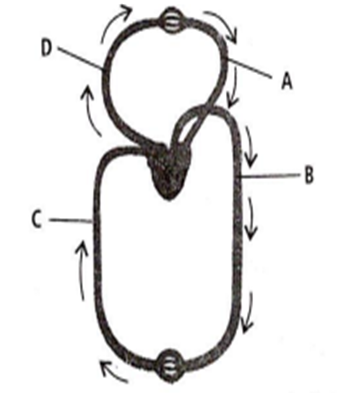
A - pulmonary vein - takes impure blood from body parts, pO2 = 60 mmHg
B - pulmonary artery - takes blood from heart to lungs, pO2 = 90 mmHg
C - vena cava - takes blood from body parts to right auricle, pCO2 = 45 mmHg
D - dorsal aorta - takes blood from heart to body parts, pO2 = 95 mmHg
The diagram given here is the standard ECG of a normal person. The P - wave represents the
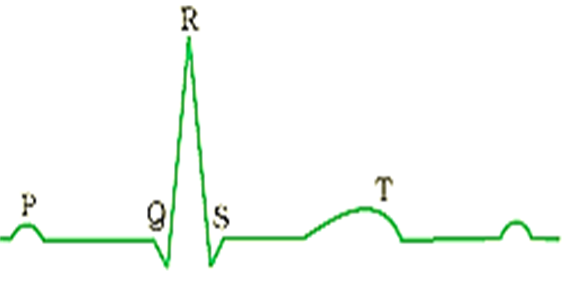
contraction of both the atria
initiation of the ventricular contraction
beginning of the systole
end of systole
Figure shows human urinary systemwith structures labelled A to D. Select option, which correctly identifies them and gives their characteristics and/of functions

A - adrenal gland - located at the anterior part of kidney. Secrete catecholamines, which stimulate glycogen breakdown
B - pelvis - broad funnel shaped space inner to hilum, directly connected to loops of Henle
C - mediulla - inner zone of kidney and contains complete nephrons
D - cortex - outer part of kidney and do not contain any part of nephrons
